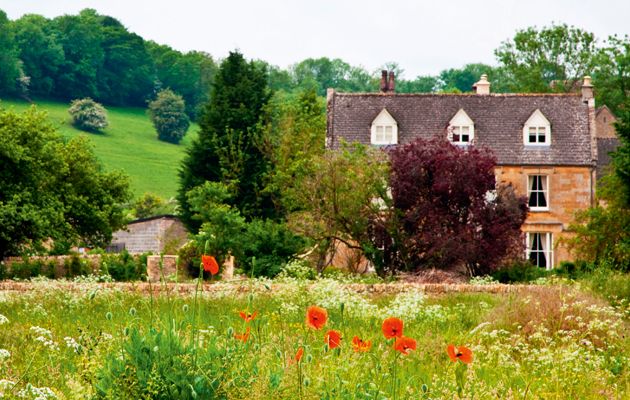A buyer's guide: moving to the country
Ptolemy Dean describes his own experience of buying rural property and moving to the country. He advises how to make the dream a reality.


The process of buying a country house seems to grow ever more onerous, with the demands of mortgage paperwork and legal checks. Once all of these risks have been duly managed, reviewed and signed off, however, the happy moment finally arrives when the purchaser swings up the drive to their newly acquired dream country house. This is when the fun really starts. Assuming they’ve avoided all the conveyancing potholes (and those left in the verge by the previous owners’ removals lorry), what might they expect to find?
In our case, it was not an altogether pre-possessing start. The driver of our removals lorry had to cut down a number of overhanging branches just to get his vehicle down the drive. And after his team had unloaded our possessions and the sun set, we rather wanted to leave with them. The previous elderly owners had left after an occupation in excess of 50 years. In the deserted and peaceful emptiness, the gloominess of our new rooms was exaggerated by grimy windows and overgrowth beyond. The only enlivening detail was the fluttering of carpet moths in the gloaming, which suggested that the gift of the existing finishes had been less generous than we had hoped.
On the first day, a cascade of rusty brown water containing chunks of saturated plasterboard from a water tank whose ball cock had become wedged in the ‘refill’ position fell in a tidal wave. This indicated that the kind gesture of temporarily turning off the mains had been something of a disaster, especially as it coincided with the maiden visit of the very underwhelmed parents-in-law.
All the usual delights were there. Ancient electrics, chewed by mice, were fixed into walls so damp that even the plastic clips had disintegrated. Old kitchen units masked primitive and ineffective bituminous tanking treatments that provided cosy bedding for mice not otherwise engaged in the consumption of wires. In any new house, these things are likely to be in need of renewal, if not for their poor condition, then often for their aesthetic shortcomings. The last major works to our house could be dated back to the previous generation, who must have arrived young, optimistic (and similarly cash-strapped) in the 1960s —a period not celebrated for its sympathetic alterations to period buildings.
But later periods weren’t always much better. The 1970s and 1980s brought Artex and Woodchip, both hellish to remove from old lime plasters, which often detach from their timber laths in the process. The thick application of treacly black paint to exposed timber beams is another inexplicable fashion from this period. Removal can be so onerous that a thorough coating of stone-white paint can defer the challenge to one’s successors without irre- versible harm to the building fabric.
A common mystery that arises in country houses is why the attics (often originally set aside for staff from the era of Downton Abbey) so often remain in disuse. Apart from the clusters of flies that can breed in the window frames, beware especially an attic whose floor has recently been swept in a building otherwise choking with dust. The more commercially savvy breed of vendor will stop at little to erase evidence that bats, and their tell-tale droppings, occupy any part of their premises.
With bats potentially come bat surveys, ecologist costs and the need to acquire a licence from Natural England for works that could affect their habitats or maternity roosts. These stipulate restrictions on the timing of repairs that can’t disturb these modest beasts. As with everything, the process can be successfully managed, but not at the speed necessarily dictated by the start of the next school term.
Sign up for the Country Life Newsletter
Exquisite houses, the beauty of Nature, and how to get the most from your life, straight to your inbox.
Other challenges may lurk in the basement, another area the estate agent will have doubtless promised has ‘bags of potential’. Here, asbestos can remain hidden around boilers, chimney flues and, occasionally, in a plastered bandage form around old heating pipes. Asbestos undisturbed should cause no concern, but if alterations are planned, an asbestos survey is essential for protection of occupants and building workers alike. Removal can involve people turning up in special space suits and breathing apparatus—entertaining for the children, but less so for the bank balance.
If all of this sounds off-putting, then there is always the garden as a reminder as to why you bought the place originally. But even here, beware the rabbits that burrow down into the footings of outbuildings and the deer that rip into garden shrubs and climbers. All that horrid tall fencing is there for a reason. And then there are the human neighbours, with the potential stresses that arise from rights of shared access and those who gawp from adjacent public footpaths or allow their dogs to bark all night.
Challenges there certainly are to life in the country, but the fresh air, beautiful landscape and escape that it offers, especially after a long week, more than make up for them. Good quality advice is readily available and help is always at hand for those new to the game, to ensure that their dream country house remains precisely that in reality.
Ptolemy's top tips
- Allow time Everything takes much longer than anyone expects (and be very wary of assurances to the contrary). Purchase processes are slow, consents can take months to prepare and process and builders can be hard to find.
- Find the correct adviser Someone who has designed an urban media suite in a Clapham basement is very unlikely to be suitable to advise on work to a listed building in the country. Don’t underestimate the specialist knowledge needed.
- Beware of concealed fabric These are the areas that the surveyor’s report noted as ‘excluded’ in the small-print section, as access wasn’t possible. Damp wooden floors concealed by the previous owners’ carpets and laid with no ventilation can lead to rot, which can remain undetected for decades. Leaking roofs can drain into wall voids, again undetected until significant damage has been caused.
- Don’t overreact to problems Very often, less invasive solutions to manage difficulties such as dampness can be achieved by treating the causes of decay rather than overreacting to the symptoms— and often at considerably lesser cost.
- Get consents early If major alterations are envisaged, consulting planning or conservation officers early can save time and money developing proposals that may not fall within the council’s policies.
- Get more information on a listed building If a building is listed, find out more about its age and construction. An understanding of its history can be as informative as a patient’s medical history might be for a doctor.
- Beware bats Look out for them in the roof space if works are planned. ‘Emergence’ surveys can only be carried out at times when bats are not in hibernation. Not having the correct report can potentially delay approval of a planning application over the whole length of a winter.
- And beware asbestos Asbestos often occurs in and around old service installations, chimneys and more generally in early-to mid-20th-century construction. Surveys can establish where this occurs so any removal can be carried out before building works begin and avoid possible delay due to health-and-safety shutdown.
- Don’t create built-in problems There is a regrettable tendency to over-specify modern electrical services, often building them deeply and irreversibly into historic fabric at considerable cost. Recessed spotlights, ceiling loudspeakers and excessive computer wiring can achieve a department store appearance that will leave a costly legacy for your successors when all these services inevitably become as obsolete as those that preceded them.
- Use the right builder Last but not least, an insensitive builder, ignorant of historic construction and repair methods, can very quickly turn an authentic and charming country house into something regularised and commonplace, devaluing its aesthetic appearance, destroying much of its historic value and probably diminishing its fiscal value at the same time. Once it’s gone, that’s it. These places are irreplaceable.
Country Life is unlike any other magazine: the only glossy weekly on the newsstand and the only magazine that has been guest-edited by HRH The King not once, but twice. It is a celebration of modern rural life and all its diverse joys and pleasures — that was first published in Queen Victoria's Diamond Jubilee year. Our eclectic mixture of witty and informative content — from the most up-to-date property news and commentary and a coveted glimpse inside some of the UK's best houses and gardens, to gardening, the arts and interior design, written by experts in their field — still cannot be found in print or online, anywhere else.
-
 Burberry, Jess Wheeler and The Courtauld: London Craft Week 2025 explained
Burberry, Jess Wheeler and The Courtauld: London Craft Week 2025 explainedWith more than 400 exhibits and events dotted around the capital, and everything from dollshouse's to tutu making, there is something for everyone at the festival, which runs from May 12-18.
By Lotte Brundle Published
-
 Everything you need to know about private jet travel and 10 rules to fly by
Everything you need to know about private jet travel and 10 rules to fly byDespite the monetary and environmental cost, the UK can now claim to be the private jet capital of Europe.
By Simon Mills Published
